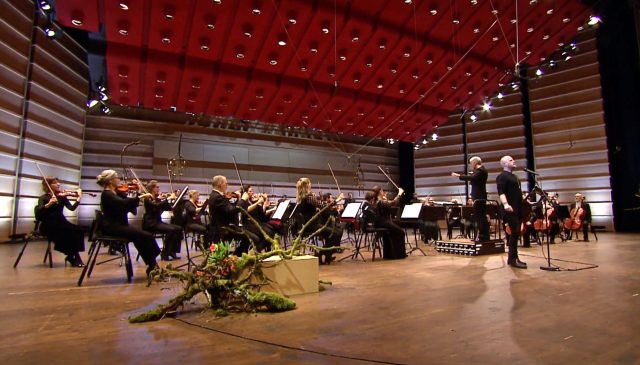
The world is a very different place compared to even a few months ago, and we are all shackled by lockdowns, social distancing and ever-increasing death rates, but in this brave new world of very real doom and gloom, there are one or two shards of light. Without wishing to sound too flippant regarding current global events, one of these has been the streaming of events from around the globe giving a wider audience the opportunity to experience shows that they might not have otherwise had the chance to see, or even be aware of.
The Bergen International Festival 2020, which is a 15 day annual celebration of the arts, is one such event. As part of this year’s festival, Norwegian composer and musician Einar Selvik was invited to take part, performing one track during the opening of the festival and performing a full, albeit stripped back, concert with several guest musicians the following evening.

Einar Selvik perhaps first came into the public eye during a stint with black metal outfit Gorgoroth, before founding Wardruna, providing music for the popular TV series ‘Vikings’ and more recently providing music for Assassin’s Creed Valhalla.
Of these, it is perhaps his role with the critically acclaimed Norwegian Nordic Folk outfit Wardruna (although in reality this label does not do justice to the band), where he remains the main composer and driving force, for which he is best known. Wardruna primarily use old Norse instruments and lean heavily upon the Poetic Edda for their work, but I will touch upon these more as the review unfolds.
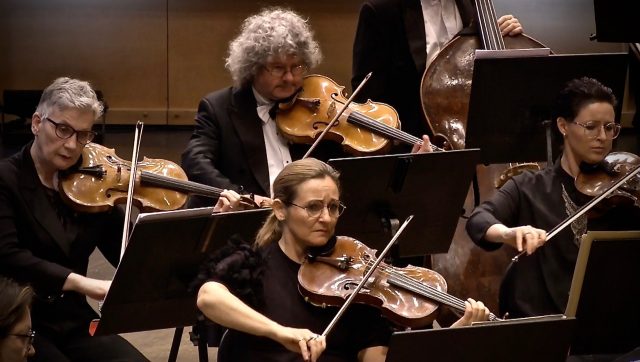
Furthermore, Selvik and his fellow musician Ivar Bjørnson (probably best known as a guitarist with Enslaved) have a previous link to the Bergen International Festival. Following the success of a previous collaboration between Selvik and Bjørnson, ‘Skuggsjá’, which was commissioned as a concert piece for the 200th anniversary of the Norwegian constitution, both were then commissioned to write a piece for the Bergen International festival 2017, resulting in the Nordvegen project and ‘Hugsjá’ work. Both ‘Skuggsjá’ and ‘Hugsjá’ have ultimately both gone on to be recorded as full length albums.
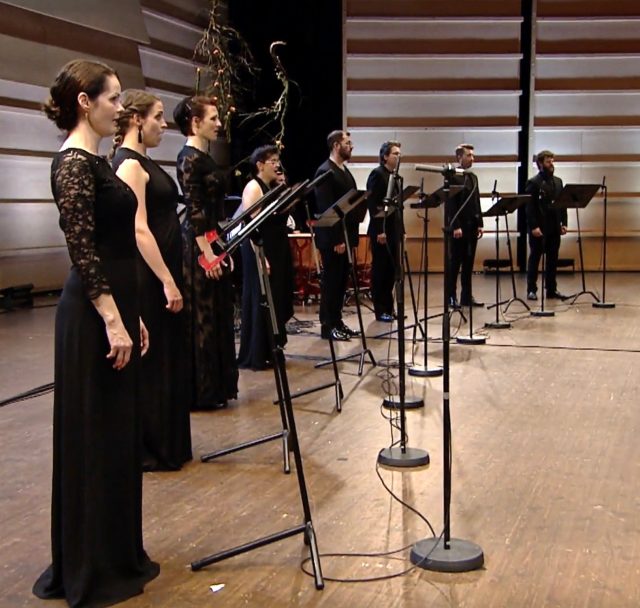
With all of this in mind, it is perfectly fitting for Selvik and his colleagues to be playing a leading role in this year’s festival.
68th Bergen International Festival 2020 Wednesday 20 May, Grieghallen, Bergen
The Grieghallen is a large concert hall located in central Bergen, named after Bergen-born composer Edvard Grieg and was the venue for the opening concert of this year’s Bergen International Festival. As part of this event, Einar Selvik took to the stage of this grand hall standing in front of the Bergen Philharmonic Orchestra and the Edvard Grieg Kor (who were all spaced appropriately to allow social distancing!).
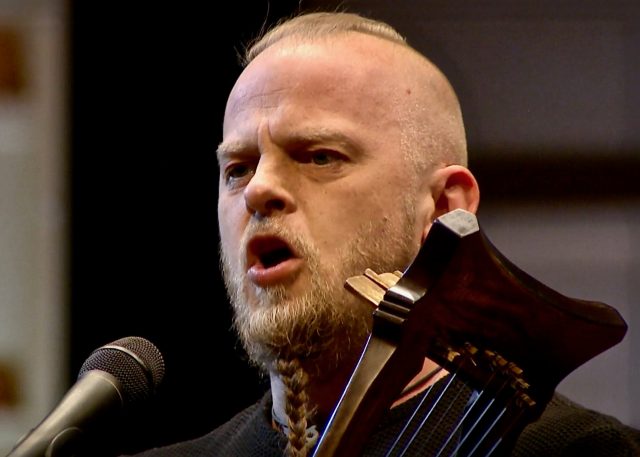
With his trademark plaited beard, sun-cross pendant, and Kravik lyre he was the obvious focal point as he launched into an emotional rendition of iconic Wardruna track ‘Voluspá’.
As the track built, Einar was joined by both the orchestra and choir who added depth and variety to the track. It was interesting see the classical musicians working in harmony with and complementing Einar’s impassioned vocals and the haunting repetitive melody of the Kravik Lyre. All too soon the track came to an abrupt end leaving an eery silence.

This collaboration worked perfectly, and I can only hope that one day I have the opportunity to witness Einar Selvik doing a full show with an orchestra and choir.
This musical aperitif nicely whet the appetite for the main event that was to follow the following evening.
May 21st, Medieval Royal Håkonshallen

The Medieval Royal Håkonshallen is a stone hall set within the walls of the Bergenhus Fortress and is the largest medieval building in Norway, reportedly over 750 years old. It was initially used for grand festivities as well as being a royal residence but today functions mostly as a museum and occasional concert venue.
This grand yet imposing venue served as a perfect backdrop for this special concert and as the concert began, Einar Selvik stood alone at front of the grandiose hall. There were instruments in position hinting towards the guests that would join him later, but for the moment, was the sole performer. Once more with his plaited beard, sun-cross and Kravik Lyre, Einar launched into the appropriately named ‘Skald’ from the Warduna album of the same name. This was an emotive performance with the passion and intensity clear on his face as his vocals resonated around the hall which seemed to have perfect acoustics for this event.
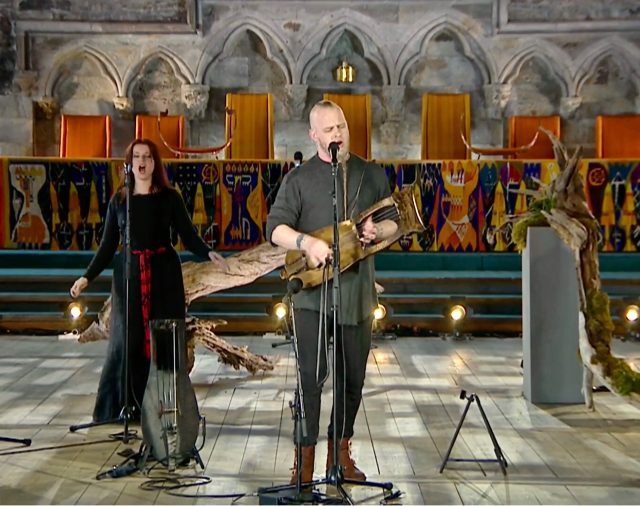
As the track came to an end, Einar paused to offer a welcome to the concert, before going on to explain the concept of the evening, namely that he and some fellow musicians were going to perform songs from Wardruna, songs written for the Bergen International Festival and for the TV show ‘Vikings’. This led nicely into the next song, which was composed specifically for a scene from ‘Vikings’ where Ragnar Lothbrok (a main character in the series and originally from the Icelandic Sagas and old Norse poetry) was thrown into a pit of snakes by King Ælle II. Einar jests (albeit with a very straight face) that like any brave warrior in that situation, Ragnar found it appropriate to do some poetry. This led into ‘Ormagardskvædi’ (Snake Pit Poetry) with Einar once more by himself with Kravik lyre. The sound was immaculate and the vocals sounded immense, full of emotion and passion as the tale unfolded.
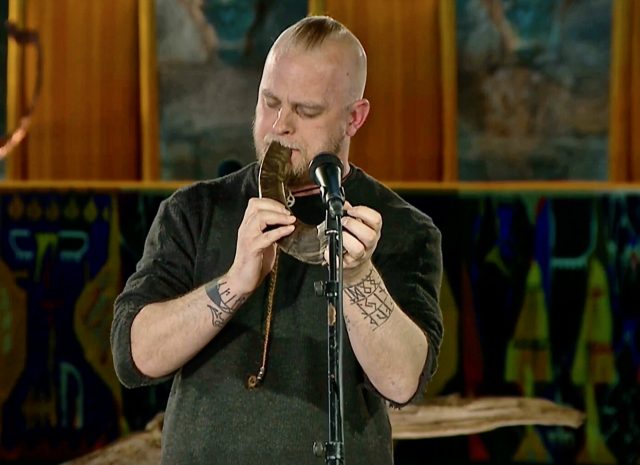
After the song ended, there was a further pause while Einar discusses his lyre. He informed us that the one he has used thus far was a recreation of one found on a medieval farm in Kravik, Norway, and is therefore known as a Kravik lyre. He reflected that this instrument has been around for thousands of years, and that there is good evidence this instrument was used during the Viking period in Scandinavia. Whereas he had plucked the Lyre like a harp during the first two tracks, he turned it sidewards for the next track to strum it like a guitar. More musicians then took to the stage and were introduced. These were:
Ivar Bjørnson: guitar and vocal
Iver Sandøy: drums, percussion, vocals
Lindy-Fay Hella: vocals
Håkon Vinje: piano, vocals
Silje Solberg: Hardanger fiddle, vocals

With the introductions complete, it was time to introduce the next track ‘Fehu’. We heard that this translates to cattle or livestock and is associated with wealth. While based loosely around livestock, we heard that the song circles around a handful of rune poems that reflect that while being wealthy is of course a blessing, it also causes arguments between kin, friends, neighbours and even countries. Einar explains the meaning of this song links into his interpretation of another rune poem based around the Linnorm, a mythical dragon/serpent like creature. The legend is that, if the Linnorm sleeps on your gold, the gold will increase, but the flip side is that the serpent grows equally so you get rich but you also get a big serpent to handle, which is a nice analogy to the double edged sword that wealth can be. The intro was played on the Karvik lyre but this was soon joined by the rest of musicians for a relatively faithful but minimalistic rendition of the original version. Backing vocals from Lindy-Fay Hella were particularly striking lending a new dimension as the track progressed which was really good to hear.
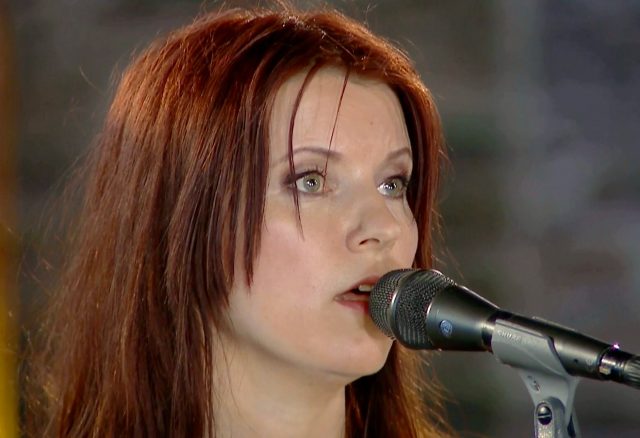
After the track finished, Lindy-Fay Hella left the stage while the next track was introduced as a piece that Einar Selvik and Ivar Bjørnson had written as part of their commissioned work for the Bergen International Festival 2017, and specifically a song about the sun and circles which are central to many old world myths and beliefs, leading into ‘Ni Mødre av Sol’ (Nine Mothers of the Sun). This started with Silje Solberg on the Hardanger fiddle before Einar’s vocals with backing vocals and percussion from Iver Sandøy built up the layers nicely, with guitar and piano adding further textures as the track progressed. Einar Selvik inevitably remained the focal point and the passion, commitment and intensity were obvious with him singing much of the track with his eyes closed and reaching out in front of him and to the skies. It was clear how personal this music is to him.
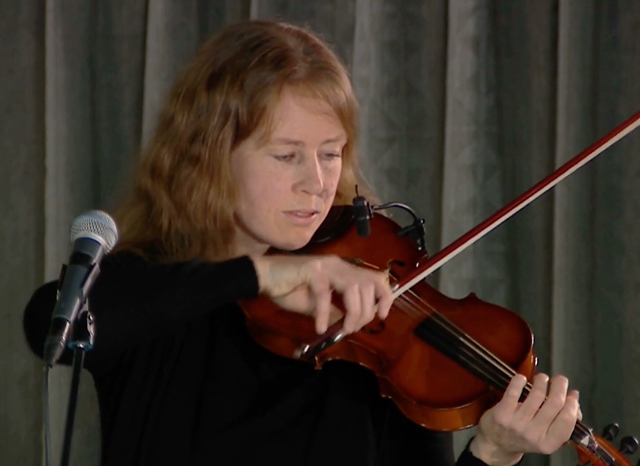
The track ended abruptly and it occurred to me how odd it is to have a live track end and be greeted by silence. Selvik looked humble, perhaps even a little awkward as he went on to introduce the next track which was also born during the Nordvegen project, and a was a reworking of Enslaved track ‘Return to Yggdrasil’. For Nordvegen this was rearranged into Norwegian, given a different set up and reborn ads‘Heim til Yggdrasil’. This was very different to Enslaved original with the acoustic guitar work of Ivar Bjørnson and Håkon Vinje’s piano prominent alongside the passionate vocals. The haunting guitar melody built, being both evocative and emotive, building the intensity as track progresses with percussion and fiddle adding extra depth.

The track ended suddenly and the guest musicians left the stage as Einar picked up a different lyre. He explained that this was a Taglharpe before explaining that the next track was to be a song about sorcery. The Taglharpe was played with a bow leading the intro to ‘Vindavla’, also from the Skald album, before emotive vocals joined, creating hypnotic rhythms and it became very easy to immerse yourself completely in the music.
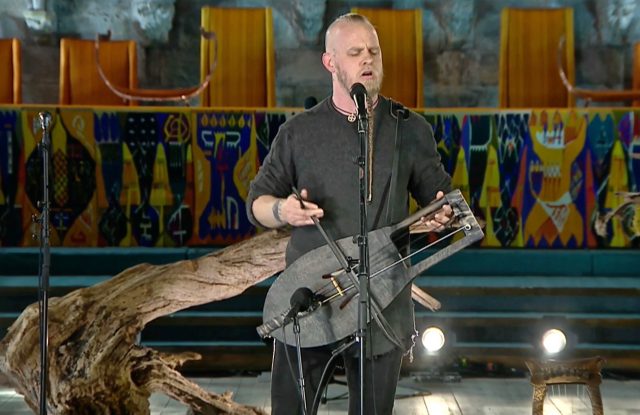
The Taglharpe was swapped for the Karvik lyre once more, before the next track was introduced. We heard that the piece was originally written by the prominent 19th century Norwegian musician Petter Strømsing with the intention of it being played at his own funeral, and in due course it had been performed by Petter’s oldest son over his coffin. We were told that Einar has put his own words to this funeral song and made his own adaptation of it, now known as Gravbakkjen (the burial hill). With such this subject and background story, the rendition was understandably emotional as Einar plucked at the Karvik lyre and and sang his own lyrics for this version. He looked almost vulnerable as he stood alone at the front of the hall performing these emotional tracks with respectful humility.
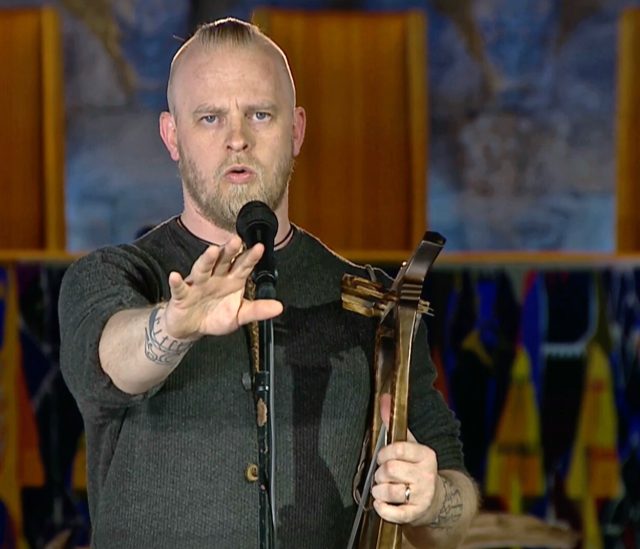
Before the next track, Einar explained that old Norse poetry is something he has profound respect for and that he has great humbleness when working with some of these old poems and trying to compose his own poetry in similar ways to the old skalds. He went on to announce that the next track was to be one of the most famous poems called ‘Voluspá’, and that it describes the rise, fall and resurrection of civilisation, reflecting that something needs to die for something else to live, and that this is the way of nature.

Of course, the track was performed the previous night with the augmentation of a choir and orchestra, so it was nice to hear it in its more raw form again, much closer to the album version and in some ways the simplicity seemed to give it more integrity. The depth of feeling was clear in Einar’s voice and on his face as he worked through this track, still by himself at the front of the great hall. As the track progressed the passion in his voice and on his facial expressions grew to a fitting crescendo. Simply stunning.

Another instrument was introduced at this point, namely the goat horn (also known as bukkehorn in Norwegian). We heard that there is an unbroken tradition of using this instrument over at least 1500 years and that it was traditionally used in the mountains and pastures as a means of communicating and scaring off predators. There was then a brief demonstration of the goat horn, which at times sounded to me like a saxophone.
The rest of the musical ensemble returned to the stage while Einar introduced the next song, explaining that it explores the relationship and bond between man and wolf. The song addresses and acknowledges the value of being part of nature but also acknowledges that this has a cost, with Einar reflecting that “…if it has a cost, it has a value.” The track which followed was ‘Grå’ from the forthcoming Warduna album ‘Kvitravn’. The full set of musicians created a deeper, more complex sound with multiple layers, but particular mention must go to Lindy-Fay Hella whose backing vocals were exquisite. Having said that, every element played its part in creating this stunning live track, and if this is what we can expect from the forthcoming album then I can’t wait.
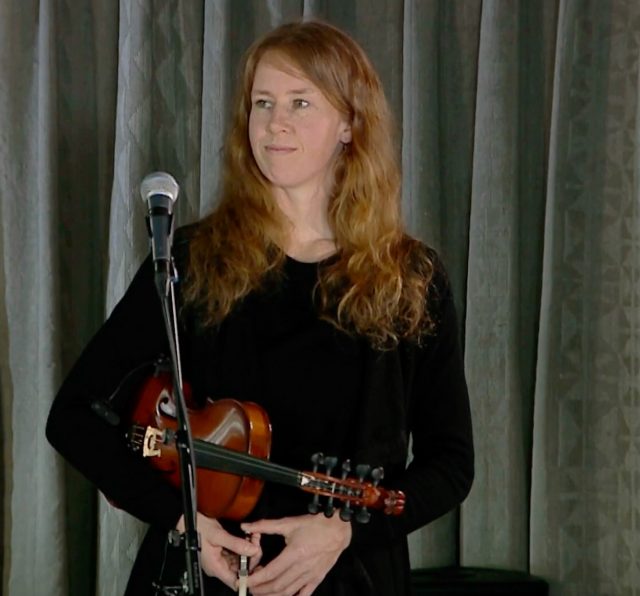
Before the final track, we hear that Warduna and the other projects are not about copying the past but learning from it, remembering it and creating something new. Einar reflected that song used to be a central part of life and culture but this has now mostly gone. He mused that there used to be songs for when you were born, when you were sowing or reaping the field, picking apples spinning thread or baking bread and also for death. He explained that traditionally when somebody died people ‘sang them across’ and that there were songs specifically for this. We are told that the final track is based around this concept and “is a song about death, about dying about remembering somebody you have a lost, a song about crossing over and about letting go’” inevitably leading into the phenomenal ‘Helvegen’.

This is my personal favourite Warduna track and whenever I hear it, it always hits me hard emotionally such is its raw emotive power. This time however, it sounded different to both the recorded version and also to the numerous times I have heard it live. The differences may be subtle but for seem reason, tonight’s version lacked the intensity of other occasions. It’s hard to put my finger on exactly why, and it may simply be that my expectations of the track, and specifically how it makes me feel, have grown such that I now have unrealistic expectations. Having said that, this was still immense and one of my highlights of the set.
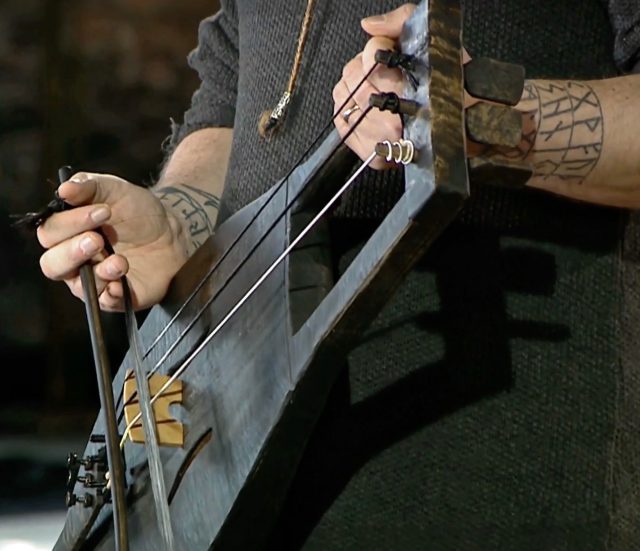
As the echoes of the song faded, Einar offered a simple “Tusen takk fra oss” (Thanks for having us) and the set was over.
This was a simply jaw dropping performance in exceptional circumstances. Sadly Wardruna’s tour has had to be rescheduled due to COVID19, but they will return to our shores (all being well!) next April. I will be at as many of the dates as possible and urge you to get along if at all possible.
Review and screenshot capture/editing by Andy Pountney

Leave a Reply